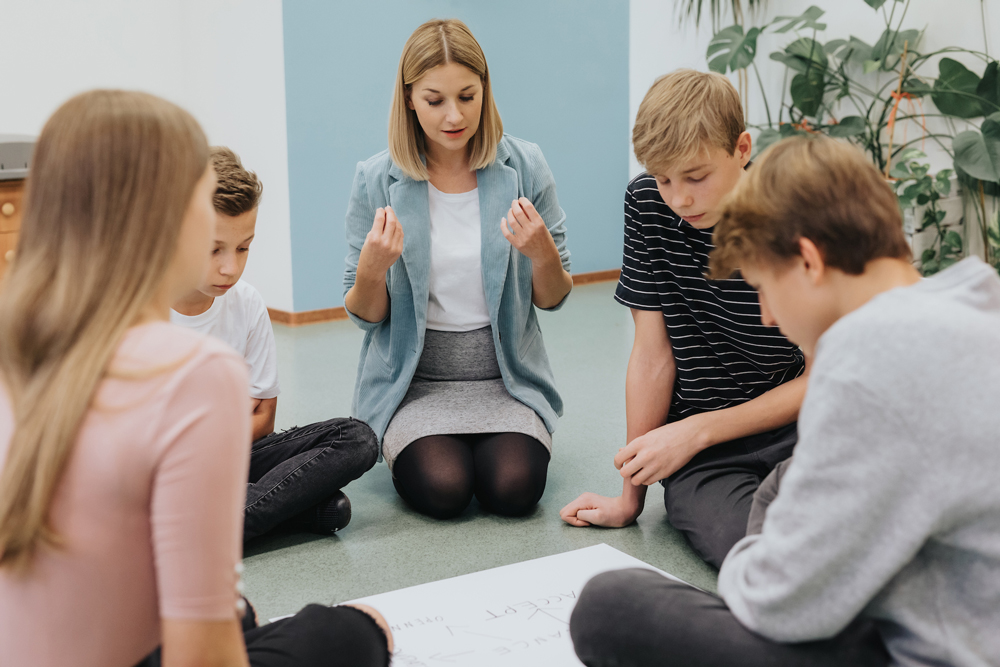Technology can create the illusion of connection through a snap, a tweet, or a post. Unbeknownst to our kids who use technology daily, they are depriving themselves of one of the most profound characteristics that make us human–genuine, face-to-face relationships. Building student-to-student relationships is a crucial aspect of classroom performance, as is building student-teacher relationships. But how do you build authentic relationships with students? You can start by implementing a few key strategies and activities to build relationships in your classroom.
What are some strategies for building relationships in the classroom?
1. Journal about your interactions and self-reflect.
To build effective student and teacher relationships, it’s helpful to start with yourself. Taking time for objective self-reflection and using a journal to record your observations about what is happening in your classroom will help you identify patterns that have developed in your student-teacher relationships.
Pay special attention to possible triggers and document them. When you understand what types of interactions elicit strong emotional responses, such as frustration, anger, or despair, you can make adjustments and try a different approach.
2. Become keenly aware of your students’ interests and what motivates them to excel.
Focus on your students and their behaviors and work on building student-teacher relationships. At the beginning of each school year, consider taking the time to visit students at their homes. This can be a brief visit to introduce yourself and become familiar with the student’s goals and interests. By literally meeting your students where they are, you create opportunities to get to know them more personally.
If you listen closely to student conversations, you’ll learn naturally what interests them and what they find most important. Then you can take what you’ve learned about your students and create a classroom environment and lessons that tie into the things that motivate your students to excel.

3. Incorporate student storytelling time.
Create opportunities for students to share their ideas and stories on a digital display board weekly. This activity helps them discover that they have more in common with their peers than they thought. In addition, it cultivates student-to-student relationships in the classroom.
Think about this for a moment. When you were a kid, who was the first person you wanted to tell when you achieved a goal or had done something special? The most common answers are Mom or Dad. We love to celebrate victories with the most important people in our lives. Sharing stories and achievements can open up dialog among your students and create bonding moments that build trust.
Now that we’ve identified a few critical strategies for building relationships in the classroom, let’s focus on some activities to build relationships with students.
Team-building activities for early childhood educators
- Two truths and a deception – Tell three things about yourself. Two are true, and one is false. Then, your students must see if they can pick out the one that’s not true.
- Indoor scavenger hunt – Give students the opportunity to get to know your classroom by breaking them into teams and creating an indoor scavenger hunt.
- Line-up-hula-hoop-pass – Have your students create a line and hold hands. Then, they must pass the hula hoop down the line without letting go.
Team-building activities for teens
- Spot the difference – Break your students into two lines facing each other and give them two minutes to observe each other in their lines. Next, have your student lines turn their back to each other. While they have their back turned to each other, they can change their appearance. After a few minutes, the students will face each other again, but they have to point out the differences between the first time they faced each other and the second time.
- Fear in a hat – This exercise takes a more serious tone. You’ll want to introduce the topic of fear and the fact that there cannot be courage without fear. Let each student write down a personal fear and then drop it into the hat. Randomly select individuals to pull a fear out of the hat and read it aloud. Facilitate discussion around each fear. This allows your students to face their fears and realize that they are not so different from their peers.
For more ideas on building relationships with students, subscribe to Avanti. You’ll get access to over 250 (plus more each month) on-demand, short videos with strategies on relevant topics for today’s teachers. Created by teachers for teachers, Avanti’s videos give you proven strategies you can apply in your classroom immediately.
